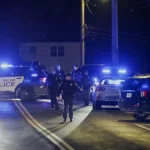
–>
September 18, 2022
Some view any unwillingness to increase gun safety regulation for the sake of “the children” — the sine qua non of virtue-signaling — as “evil.” But can a complex, multi-faceted issue like national gun policy be accurately analyzed along a single dimension to the benefit of all citizens?
‘); googletag.cmd.push(function () { googletag.display(‘div-gpt-ad-1609268089992-0’); }); }
No responsible gun-owner debates the lethality of firearms or the need to exercise caution when using any dangerous device, from kitchen disposals to chainsaws. Nor is it likely any would oppose manufacturers’ efforts to make firearms as safe as possible. What is contested are regulations that restrict responsible use of firearms under the guise of safety, for the sake of the children, or any manner of other reasons that are unsubstantiated.
When arguments to disarm Americans for “the children” are examined, three things emerge: 1) a lack of evidence; 2) a pivot from evidence to emotion to garner support; and 3) a desperate call for governmental intervention that disregards 1) the U.S. Constitution and/or 2) parameters for sound public policy. We have space to consider point #1. Upcoming articles will address those that remain (e.g., school shootings and international homicide rankings).
If homicides and suicides express a willingness to take human life, it’s hard to imagine how more gun safety regulation, designed to spare human life, might apply. That leaves accidental shootings as the principal target for such legislation — e.g., “children unwittingly shooting children.” Aftermath.com reports that 6,885 died from accidental shootings between 2006 and 2016: 625, on average, annually, or 0.0002% of Americans. Querying CDC’s WISQARS, there were 63 accidental gun deaths in 2020 among children aged 0 to 9 and 93 deaths among those aged 0 to 14, affecting 0.0002% of each age group. Adding 15- to 19-year-olds, accidental firearm deaths totaled 149, affecting (you guessed it) 0.0002% of 0- to 19-year-olds. Six hundred twenty-five accidental deaths among 400M guns implies 99.99984% were safely used — near perfection. Rather than heralding “danger for children” (or anyone), the data seem to shout, “Americans are safe gun owners,” and that’s before acknowledging public policy’s impotence regarding 1) bona fide accidents, where the unavoidable happens in spite of precautions taken, and 2) citizens who, by nature, are more lax when it comes to safety — likely driving up inadvertent poisonings and chainsaw accidents as well.
‘); googletag.cmd.push(function () { googletag.display(‘div-gpt-ad-1609270365559-0’); }); }
By the way, it should also be noted, per the CDC, that 1% of all deaths in the U.S. for all age groups in 2020 were by firearm. Doesn’t a 99% deserve an A+?
One of the newest “for the children” crusaders is the medical establishment. Its entry marks an inflection point in the gun control debate, for most view it as a neutral and objective voice driven solely by science, data, and evidence. But is it? The New England Journal of Medicine (NEJM), one of the premier medical journals in the world, published an article cited in my prior article. The analysis has been used repeatedly by scores of new outlets as proof that “guns make children unsafe.” The crux of the position is this: governmental regulation is required to “fix” gun violence, just as it did motor vehicular deaths. Ignoring the arbitrariness of the comparison, what do the numbers say? They say three things that contradict the position.
Note: Different NEJM articles use different age ranges — e.g., 1 to 24 and 1 to 19. I will use 0 to 19 because those <1 year of age are most vulnerable, and an upper limit of 19 favors the anti-gun position in comparisons of motor vehicular to firearm deaths.
First, per the CDC, in 2020, 99% of 0- to 9-year-olds and 97% of 0- to 14-year-olds died by something other than a firearm. Parsing the data to include 15- to 19-year-olds — 83% of firearm deaths among those aged 0 to 19 — catapulted firearm deaths above motor vehicle deaths for the first time in two decades — NEJM’s principal point. However, classifying 15- to 19-year-olds as “children and young adolescents” in a culture that does all it can to goad the innocent into adulthood seems disingenuous. While it’s sensible to assert that three-year-olds are children, often confined to playpens and nearly 24/7 parental oversight, most 15- to 19-year-olds are largely autonomous. This group chooses its movies, music, friends, clubs, gangs, cults, etc.; engages in sexual relations; uses recreational drugs; views porn; takes gender transition hormones (in some states); has abortions (in some states); joins the military; etc. On what basis should adult-level decision-making warrant inclusion in child (or even adolescent)–level statistics? When 15- to 19-year-olds are excluded, motor vehicular fatalities exceed firearm fatalities by 1.8x.
Second, the NEJM and other similar analyses typically include suicides. If guns make America unsafe, on what basis should suicides be included when the perpetrator is a threat to only himself? How many people feel less safe walking the streets of America because a thousand 15- to 19-year-olds killed themselves in 2020? Deep sadness, perhaps — but that’s an entirely different emotion. How will more gun control, gun safety regulation, etc. lessen anyone’s decision to kill himself? Don’t suicides by any means belong in a different conversation? When suicides are excluded, motor vehicle deaths exceed firearm deaths by 1.3x.
Third and perhaps most damning, NEJM’s analysis includes ICD (International Classification of Disease) codes for “unspecified firearms.” ICD codes, authored by the World Health Organization (WHO) and adopted by member nations (e.g., the U.S.’s CDC) in 1999, are used to encode cause of death on death certificates. Three broad categories for firearms exist: 1) handguns; 2) rifles, shotguns, and other large-caliber weapons; and 3) “other unspecified firearms.” Curiously, CDC Wonder in 2020 reported that 82% of all firearm deaths were encoded “unspecified.” How can 82% of gun-related deaths be “unspecified” for those aged 0 to 19 when Pew Research estimates that 100% of legally owned firearms are either handguns or shotguns, rifles, and other large-caliber weapons — each with its own ICD code? It can’t.
‘); googletag.cmd.push(function () { googletag.display(‘div-gpt-ad-1609268078422-0’); }); } if (publir_show_ads) { document.write(“
Recently, a medical research team confirmed this understanding when it reduced CDC firearm injuries by 45% because “unspecified firearm” included non-powder injuries inconsistent with the definition of a firearm: “a weapon that uses a powder [gun powder] charge to fire a projectile.” Gunpolicy.org agrees: “unspecified firearms” includes non-powder firearms — e.g., Airsoft Guns, BB (pellet) guns, flare guns, etc. Excluding 2020 unspecified firearm deaths for those aged 0 to 19, automobile accidents exceed firearm deaths by nearly 2x, eviscerating the NEJM’s (Johns Hopkins, Univ. of Mich., etc.) position.
It’s worth noting that classifying 82% of firearm fatalities as “unspecified” is as meaningless as classifying 82% of an expense as “miscellaneous.” Just as an auditor would demand transaction detail to validate expenses included; so too Americans should demand greater detail before relying upon governmental statistics where 82% of firearm deaths are catalogued as something other than a “weapon that uses a powder [namely, gunpowder] charge to fire a projectile.”
So what’s the real firearm threat in America? Answer: less than anyone is reporting.
Image via Pexels.
<!– if(page_width_onload <= 479) { document.write("
“); googletag.cmd.push(function() { googletag.display(‘div-gpt-ad-1345489840937-4’); }); } –> If you experience technical problems, please write to [email protected]
FOLLOW US ON
<!–
–>
<!– _qoptions={ qacct:”p-9bKF-NgTuSFM6″ }; ![]() –> <!—-> <!– var addthis_share = { email_template: “new_template” } –>
–> <!—-> <!– var addthis_share = { email_template: “new_template” } –>





